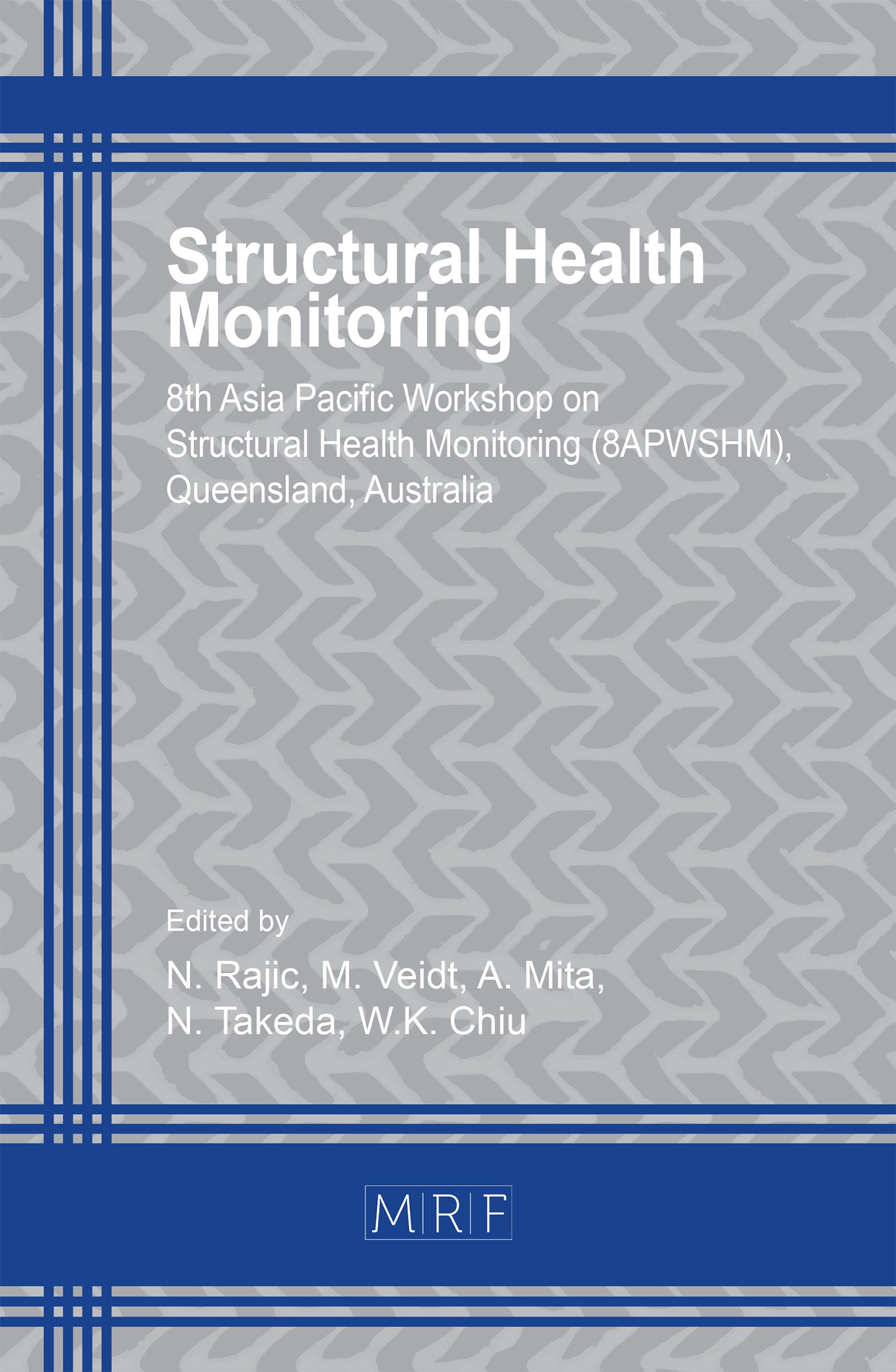Assessment of the Structural Integrity of Timber Utility Poles Using Ultrasonic Waves
Jad El Najjar, Samir Mustapha
download PDFAbstract. In this study, guided stress waves were used to evaluate the conditions of a timber utility pole experimentally and numerically using COMSOL Multiphysics. Macro Fiber Composites (MFCs), due to their flexibility and convenience to install on curved surfaces, were used to actuate and sense guided waves along the tested specimens. Based on the wave propagation characteristics in these types of structures, an MFC actuator ring, which was developed in the previous work, was applied to tune and enhance the propagating wave modes of interest. The designed ring was used to excite longitudinal ultrasonic wave modes, mainly L(0,1), for the purpose of determining the embedded length of the pole. For the damage localization a single MFC excitation was used which proved to be more efficient than the actuator ring. Embedding the timber in soil had minimum impact on the wave propagation characteristics, given that the waves were confined in the timber pole with minimal leakage to the surrounding. The embedded length was determined accurately for sound and damage timber, using both experimental and numerical data with an error of less than 3 %. The deterioration in the timber structure, within the embedded region, was also evaluated with high accuracy of 93 %. Based on the obtained results, guided waves have high potential to be used as a non-destructive tool for the assessment and evaluation of timber utility poles.
Keywords
Structural Health Monitoring, Timber Utility Poles, Guided Waves, Macro Fiber Composites, Damage Detection, Embedded Length Assessment
Published online 2/20/2021, 15 pages
Copyright © 2021 by the author(s)
Published under license by Materials Research Forum LLC., Millersville PA, USA
Citation: Jad El Najjar, Samir Mustapha, Assessment of the Structural Integrity of Timber Utility Poles Using Ultrasonic Waves, Materials Research Proceedings, Vol. 18, pp 131-145, 2021
DOI: https://doi.org/10.21741/9781644901311-16
The article was published as article 16 of the book Structural Health Monitoring
![]() Content from this work may be used under the terms of the Creative Commons Attribution 3.0 licence. Any further distribution of this work must maintain attribution to the author(s) and the title of the work, journal citation and DOI.
Content from this work may be used under the terms of the Creative Commons Attribution 3.0 licence. Any further distribution of this work must maintain attribution to the author(s) and the title of the work, journal citation and DOI.
References
[1] EP DeGarmo, JT Black, RA Kohser and BE Klamecki, “Materials and process in manufacturing, 9th ed.” Prentice Hall, Upper Saddle River, pp, 1997.
[2] M Subhani, “A Study on the Behaviour of Guided Wave Propagation in Utility Timber Poles”, University of Technology Sydney, 2014.
[3] U Dackermann, Y Yu, E Niederleithinger, J Li and H Wiggenhauser, “Condition assessment of foundation piles and utility poles based on guided wave propagation using a network of tactile transducers and support vector machines”, Sensors 17(12), pp 2938, 2017. https://doi.org/10.3390/s17122938
[4] U Dackermann, B Skinner and J Li, “Guided wave–based condition assessment of in situ timber utility poles using machine learning algorithms”, Structural Health Monitoring 13(4), pp 374-388, 2014. https://doi.org/10.1177/1475921714521269
[5] Y Yu, U Dackermann, J Li and N Yan, “Guided-wave-based damage detection of timber poles using a hierarchical data fusion algorithm”, Proc. of Australasian Conference on the Mechanics of Structures and Materials, Lismore, pp 1203-1208, 2014.
[6] B Pavlakovic and M Lowe, “Disperse Software Manual Version 2.0. 1 6B”, Imperial College, London, UK, pp, 2003.
[7] F Seco and AR Jiménez, “Modelling the generation and propagation of ultrasonic signals in cylindrical waveguides, Ultrasonic waves, 1”, InTechOpen, pp 1-28, 2012. https://doi.org/10.5772/29804
[8] DE Kretschmann, “Mechanical properties of wood, Wood handbook: wood as an engineering material, 5”, Forest Products Laboratory, pp 5.1-5.46, 2010.
[9] AB Thien, “Pipeline structural health monitoring using macro-fiber composite active sensors”, Dissertation, University of Cincinnati, United States, 2006. https://doi.org/10.2172/883462
[10] J El Najjar and S Mustapha, “Understanding the guided waves propagation behavior in timber utility poles”, Construction and Building Materials, pp 1-21, 2020.
[11] C Multiphysics, “Introduction to COMSOL Multiphysics®”, COMSOL Multiphysics, Burlington, MA, accessed Feb 9, pp 2018, 1998.
[12] S Marburg, “Six boundary elements per wavelength: Is that enough?”, Journal of Computational Acoustics 10(01), pp 25-51, 2002. https://doi.org/10.1142/S0218396X02001401
[13] S Mustapha and L Ye, “Leaky and non-leaky behaviours of guided waves in CF/EP sandwich structures”, Wave Motion 51(6), pp 905-918, 2014. https://doi.org/10.1016/j.wavemoti.2014.03.004
[14] D Bieker and S Rust, “Non-destructive estimation of sapwood and heartwood width in Scots pine (Pinus sylvestris L.)”, Silva Fennica 44(2), pp 267-273, 2010. https://doi.org/10.14214/sf.153
[15] MA Fakih, S Mustapha, J Tarraf, G Ayoub and R Hamade, “Detection and assessment of flaws in friction stir welded joints using ultrasonic guided waves: experimental and finite element analysis”, Mechanical Systems and Signal Processing 101, pp 516-534, 2018. https://doi.org/10.1016/j.ymssp.2017.09.003
[16] J El Najjar and S Mustapha, “Understanding the Wave Propagation Behavior in Timber Structures towards Application in the Assessment of Utility Timber Poles”, Civil Structural Health Monitoring, pp, 2020. https://doi.org/10.1007/s13349-020-00417-0































